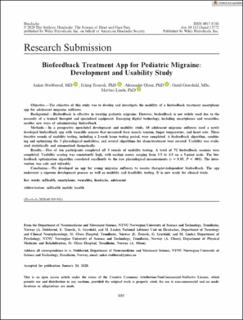| dc.description.abstract | Objective
The objective of this study was to develop and investigate the usability of a biofeedback treatment smartphone app for adolescent migraine sufferers.
Background
Biofeedback is effective in treating pediatric migraine. However, biofeedback is not widely used due to the necessity of a trained therapist and specialized equipment. Emerging digital technology, including smartphones and wearables, enables new ways of administering biofeedback.
Methods
In a prospective open‐label development and usability study, 10 adolescent migraine sufferers used a newly developed biofeedback app with wearable sensors that measured their muscle tension, finger temperature, and heart rate. Three iterative rounds of usability testing, including a 2‐week home testing period, were completed. A biofeedback algorithm, combining and optimizing the 3 physiological modalities, and several algorithms for sham‐treatment were created. Usability was evaluated statistically and summarized thematically.
Results
Five of ten participants completed all 3 rounds of usability testing. A total of 72 biofeedback sessions were completed. Usability scoring was consistently high, with median scores ranging from 3.5 to 4.5 on a 5‐point scale. The biofeedback optimization algorithm correlated excellently to the raw physiological measurements (r = 0.85, P < .001). The intervention was safe and tolerable.
Conclusion
We developed an app for young migraine sufferers to receive therapist‐independent biofeedback. The app underwent a rigorous development process as well as usability and feasibility testing. It is now ready for clinical trials. | en_US |

